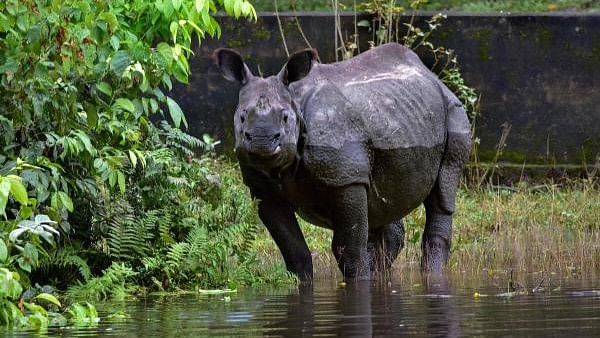
A National Park in Assam. (Image for representation)
Credit: PTI File Photo
Guwahati: More than 36 per cent of Dibru-Saikhowa National Park in Assam have been eroded in its 25 years of existence, shrinking it to only 216.53 sq km at present, according to official records.
Spread across Dibrugarh and Tinsukia districts in Upper Assam on the bank of Brahmaputra, 340 sq km of the forest was declared as National Park in 1999.
However, satellite images of 2023 obtained by the Environment and Forest Department of Assam showed that the Park's present area is 216.53 sq km only.
"That means Dibru-Saikhowa National Park's 123.47 sq km of land out of its declared area of 340 sq km have been eroded in these years," the document said.
Besides, 6.53 sq km of land is under encroachment, it added.
Along with the mighty Brahmaputra, the Dibru-Saikhowa National Park is located on the banks of other smaller rivers like Lohit, Siang, Dibru and Dibang.
"That is why it is largely affected by floods during monsoon season. During flood time, there is scarcity of shelter places for the wildlife," it added.
The Park authorities have already made requests to the Assam State Disaster Management Authority (ASDMA) through Tinsukia District Disaster Management Authority to provide mechanised rubber boats for rescuing animals during flood, the document said.
The official records also showed that when the forest was declared as National Park, 35.84 per cent of land was under tree cover.
"Out of present 216.53 sq km available land area, 38 per cent is under forest cover," it added.
The government has prepared a 10-year park management plan from 2024-25 to 2033-34 in order to prevent further erosion by the Brahmaputra, and adequate financial resources have also been mentioned in it.
It noted that the people in the two forest villages -- Laika and Dadhia -- inside Dibru-Saikhowa National Park have still been living in primitive stages and the government is taking steps to settle them in some other places.
Out of 543 families in Laika, 160 have been translocated to 72 hectares of land of Namphai forest under Digboi Division in Tinsukia district.
The remaining 383 families will be shifted to 166 hectares of land inside Paharpur Reserve Forest in Digboi division itself and the process if going on, the document stated.
Originally created to help conserve the habitat of the rare white-winged wood duck, the Dibru-Saikhowa National Park is also home to other rare creatures such as water buffalo, black-breasted parrotbill, tiger, feral horse and capped langur.
In the park, 36 species of mammals have so far been recorded. It is also an identified Important Bird Area (IBA) having more than 382 species of birds. The park is renowned for natural regeneration of Salix trees.
From November to April every year, migratory birds also visit the Park.
A total of 1,925 tourists visited Dibru-Saikhowa National Park in 2023-24, up from 1,423 visitors in 2022-23, the official records showed.
The area was declared as Dibru Reserved Forest in 1890. In 1920, an additional area was added to the Dibru Reserve Forest. On the other hand, Saikhowa Reserve Forest was declared in 1929.
In 1933, more area was added to the Dibru RF. In 1986, an area of 650 sq km was preliminarily declared as a wildlife sanctuary, out of which finally 340 sq km was declared as a wildlife sanctuary in 1995.
Dibru-Saikhowa Biosphere Reserve was declared in 1997 with an area of 765 sq km that included the 340 sq km of sanctuary area as the core.
In 1999, the 340 sq km of sanctuary area was declared a National Park.